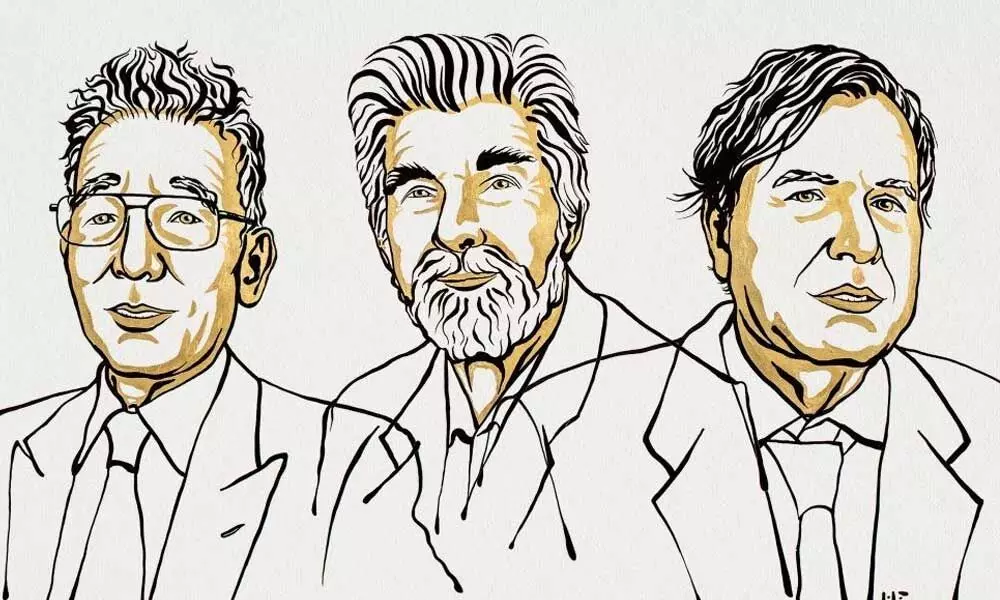Live
- They always want me to win, and now I feel lucky to have been offered a story like ‘Zebra’: Satyadev Kancharana
- ‘Democracy first, humanity first’: PM Modi in Guyana's parliament on two countries' similarities
- PKL Season 11: Telugu Titans register third straight win to top standings
- Is Pollution Contributing to Your COPD?
- NASA Unveils Underwater Robots for Exploring Jupiter's Moons
- Additional Central forces arrive in violence-hit Manipur
- AR Rahman and Saira Banu’s Divorce: Legal Insights into Common Issues in Bollywood Marriages
- 82.7 pc work completed in HPCL Rajasthan Refinery area: official
- Curfew relaxation extended in 5 Manipur districts on Friday
- Tab scam prompts Bengal govt to adopt caution over fund disbursement
Just In
Physics Nobel rewards unravelling climate systems


Physics Nobel rewards unravelling climate systems
The Royal Swedish Academy of Sciences awarded the Physics Nobel to Syukuro Manabe, Klaus Hasselmann, and Giorgio Parisi
Stockholm: Three scientists from US, Germany, and Italy were on Tuesday awarded the Nobel Prize in Physics 2021 for their contributions in discovering climate and complex physical systems.
The Royal Swedish Academy of Sciences awarded the Physics Nobel to Syukuro Manabe, Klaus Hasselmann, and Giorgio Parisi "for groundbreaking contributions to our understanding of complex physical systems", said a statement. Manabe from Princeton University, US and Hasselmann from Max Planck Institute for Meteorology, Hamburg, Germany were jointly awarded "for the physical modelling of Earth's climate, quantifying variability and reliably predicting global warming". Parisi from Sapienza University of Rome, was awarded the other half "for the discovery of the interplay of disorder and fluctuations in physical systems from atomic to planetary scales".
Manabe and Hasselmann laid the foundation of our knowledge of the Earth's climate and how humanity influences it, while Parisi got rewarded for his revolutionary contributions to the theory of disordered materials and random processes.
"Three Laureates share this year's Nobel Prize in Physics for their studies of chaotic and apparently random phenomena. Complex systems are characterised by randomness and disorder and are difficult to understand. This year's Prize recognises new methods for describing them and predicting their long-term behaviour," said the statement from the Academy.
Manabe demonstrated how increased levels of carbon dioxide in the atmosphere lead to increased temperatures at the surface of the Earth. In the 1960s, he led the development of physical models of the Earth's climate and was the first person to explore the interaction between radiation balance and the vertical transport of air masses. His work laid the foundation for the development of current climate models.
About ten years later, Hasselmann created a model that links together weather and climate, thus answering the question of why climate models can be reliable despite weather being changeable and chaotic. He also developed methods for identifying specific signals, or 'fingerprints', that both natural phenomena and human activities imprint in the climate.
His methods have been used to prove that the increased temperature in the atmosphere is due to human emissions of carbon dioxide.
Around 1980, Parisi discovered hidden patterns in disordered complex materials. His discoveries are among the most important contributions to the theory of complex systems. They make it possible to understand and describe many different and apparently entirely random materials and phenomena, not only in physics but also in other, very different areas, such as mathematics, biology, neuroscience and machine learning.
"The discoveries being recognised this year demonstrate that our knowledge about the climate rests on a solid scientific foundation, based on a rigorous analysis of observations. This year's Laureates have all contributed to us gaining deeper insight into the properties and evolution of complex physical systems," said Thors Hans Hansson, chair of the Nobel Committee for Physics, in the statement.

© 2024 Hyderabad Media House Limited/The Hans India. All rights reserved. Powered by hocalwire.com






